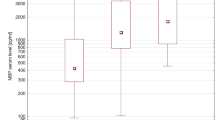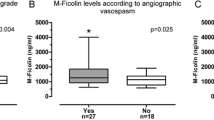Summary
We investigated the level of S-100 protein in blood as an indicator of brain damage in 71 patients suffering from subarachnoid haemorrhage (SAH) due to ruptured aneurysms.
Concentrations of S-100 protein were determined by micro-titre based immunofluorometic assay detecting predominantly S-100b on blood samples obtained 24 hours, 3 days and 7 days after onset of symptoms in patients with SAH and from 120 healthy control subjects. Neurological status was assessed using the Hunt and Hess (HH) scale on admission and by the Glasgow Outcome Scale (GOS) 6 months later.
Mean concentrations of S-100 protein in blood were significantly (p<0.0001) higher in patients 24 hours (0.263±0.387 μg/l), 3 days (0.192±0.288 μg/l) and 7 days (0.256±0.442 μg/l) after onset of SAH symptoms compared to controls (0.050±0.081 μg/l). More severe neurological symptoms (higher HH scale scores) on admission correlated with higher S-100 levels on admission (R=0.70) and Day 3 (R=0.66) (p<0.0001). Worse outcome (lower GOS score) 6 months after SAH was also associated with higher plasma concentration of S-100 in the first week after SAH.
In summary, this study showed that in patients with SAH due to ruptured aneurysm, S-100 protein levels correlate with early neurological deficit and are as sensitive as HH scores in predicting neurological outcome (GOS scores). Measurement of S-100 protein in blood is a reliable non-invasive method and may be clinically useful to screen for and monitor progression of central nervous system diseases of various origins.
Similar content being viewed by others
References
Baudier J, Glasser N, Gérard D (1986) Ions binding to S100 proteins. J Biol Chem 261: 8192–8203
Cunningham RT, Young IS, Winder J, O'Kane MJ, McKinstry S, Johnston CF, Dolan OM, Hawkins SA, Buchanan KD (1991) Serum neuron-specific enolase (NSE) levels as an indicator of neuronal damage in patients with cerebral infarction. Eur J Clin Invest 21: 497–500
Dauberschmidt R, Marangos PJ, Zinsmeyer J, Bender V, Klages G, Gross J (1983) Severe head trauma and the changes of concentration of neuron-specific enolase in plasma and in cerebrospinal fluid. Clin Chim Acta 131: 165–170
Donato R (1991) Perspectives in S-100 protein biology. Cell Calcium 12: 713–726
Fagnart OC, Sindic CJM, Laterre C (1988) Particle counting immunoassay of S100 protein in serum. Possible relevance in tumours and ischemic disorders of the central nervous system. Clin Chem 34: 1387–1391
Fanó G, Biocca S, Fulle S, Mariggió MA, Belia S, Calissano P (1995) The S100: a protein family in search of a function. Prog Neurobiol 46: 71–82
Ghobrial M, Ross ER (1986) Immunocytochemistry of neuron-specific enolase: a reevaluation. Prog Neuropathol 6: 199–221
Hårdemark HG, Almqvist O, Johansson T, Påhlman S, Persson L (1989) S-100 protein in cerebrospinal fluid after aneurysmal subarachnoid haemorrhage. Acta Neurochir (Wien) 99: 135–144
Hunt WE, Hess RM (1968) Surgical risk as related to time of intervention in the repair of intracranial aneurysms. J Neurosurg 28: 14–20
Ingebrigtsen T, Romner B (1996) Serial S-100 protein serum measurements related to early magnetic resonance imaging after minor head injury. J Neurosurg 85: 945–948
Ingebrigtsen T, Romner B, Kongstad P, Langbakk B (1995) Increased serum concentrations of protein S-100 after minor head injury: a biochemical serum marker with prognostic value? J Neurol Neurosurg Psychiatry 59: 103–104
Jennett B, Bond M (1975) Assessment of outcome after severe brain damage. Lancet 1: 480–484
Johnson P, Lundqvist C, Lindgren A, Ferencz I, Alling C, Ståhl E (1995) Cerebral complications after cardiac surgery assessed by S-100 and NSE levels in blood. J Cardiothorac Vasc Anesth 9: 694–699
Kim JS, Yoon SS, Kim YH, Ryu JS (1996) Serial measurement of interleukin-6, transforming growth factor-ß, and S-100 protein in patients with acute stroke. Stroke 27: 1553–1557
Mabe H, Suzuki S, Mase M, Umemura A, Nagai H (1991) Serum neuron-specific enolase levels after subarachnoid hemorrhage. Surg Neurol 36: 170–174
Missler U, Wiesmann M (1995) Measurement of S-100 protein in human blood and cerebrospinal fluid: Analytical method and preliminary clinical results. Eur J Clin Chem Clin Biochem 33: 743–748
Persson L, Hårdemark HG, Gustafsson J, Rundström G, Mendel-Hartvig I, Esscher T, Påhlman S (1987) S-100 protein and neuron-specific enolase in cerebrospinal fluid and serum: markers of cell damage in human central nervous system. Stroke 18: 911–918
Rosengren LE, Ahlsén G, Belfrage M, Gillberg C, Haglid KG, Hamberger A (1992) A sensitive ELIS A for glial fibrillary acidic protein: application in CSF of children. J Neurosci Methods 44: 113–119
Sindic CJM, Chalon MP, Cambiaso CL, Laterre EC, Masson PL (1982) Assessment of damage to the central nervous system by determination of S-100 protein in the cerebrospinal fluid. J Neurol Neurosurg Psychiatry 45: 1130–1135
Skogseid IM, Nordby HK, Urdal P, Paus E, Lilleaas F (1992) Increased serum creatine kinase BB and neuron specific enolase following head injury indicates brain damage. Acta Neurochir (Wien) 115: 106–111
Strand T, Alling C, Karlsson B, Karlsson I, Winblad B (1984) Brain and plasma proteins in spinal fluid as markers for brain damage and severity of stroke. Stroke 15: 138–144
Urdal P, Urdal K, Strømme JH (1983) Cytoplasmatic creatine kinase isoenzymes quantitated in tissue specimens obtained at surgery. Clin Chem 29: 310–313
Author information
Authors and Affiliations
Rights and permissions
About this article
Cite this article
Wiesmann, M., Missler, U., Hagenström, H. et al. S-100 protein plasma levels after aneurysmal subarachnoid haemorrhage. Acta neurochir 139, 1155–1160 (1997). https://doi.org/10.1007/BF01410976
Issue Date:
DOI: https://doi.org/10.1007/BF01410976




